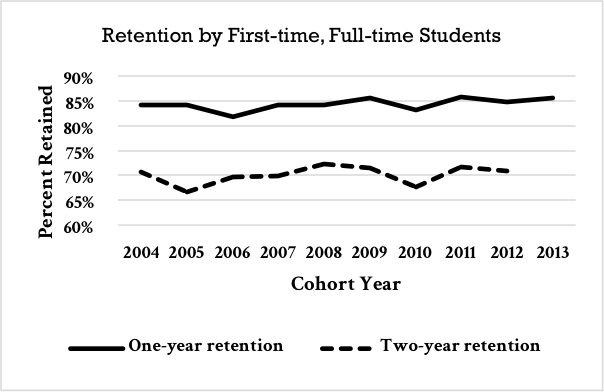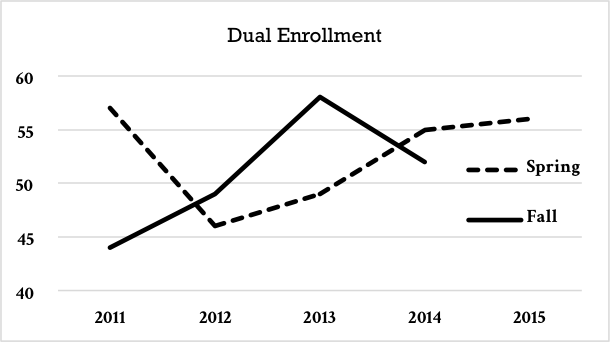Georgia College and State University Campus Plan Update 2015
Institutional Mission and Student Body Profile
Institutional Mission
Georgia College remains committed to being an integral part of the University System of Georgia’s Complete College Georgia (CCG) initiative for creating a more educated state. The CCG Campus Completion Plan initially developed by Georgia College in 2012 was built around its mission (see Georgia College Mission Statement) as Georgia’s designated public liberal arts university where excellence, engagement, and innovation are essential components of an educational experience that according to its mission “supports the needs of the region and creates pathways to individual success and personal fulfillment.” This sentiment remains today as Georgia College continues to refine and improve upon the CCG goals, strategies, and objectives previously developed.
Georgia College Mission Statement
“As Georgia’s public liberal arts university, Georgia College offers undergraduate programs of study to talented and motivated students in a residential college setting. Georgia College also provides, at multiple locations, graduate and professional studies that support the needs of the region and create pathways to individual success and personal fulfillment. Its academically engaging, student-centered programs often take learning beyond the traditional classroom and develop the intellectual, professional, and civic skills and dispositions that enable graduates to thrive in an information-intensive and diverse global society. Through its teaching, research, and service, Georgia College enriches the lives of students and their local and global communities.”
Student Profile
Georgia College’s enrollment has been stable over the past nine years. First-time freshman enrollment (see Graph 1: First-time, Full-time Students) was initially capped between 2007 and 2010 to support our mission but has experienced steady increases since 2011. Overall undergraduate enrollment also experienced moderate increases from 2006 to 2010, a small decline in Fall 2012, followed by a steady increase to its present level in 2014 (see Graph 2: Fall Undergraduate Enrollment). Further enrollment growth at Georgia College is planned for graduate programs while maintaining undergraduate enrollment at its current levels.
From Fall 2006 to Fall 2013, the academic profile of the incoming classes improved in quality as evidenced in average SAT scores with an increase from 1125 to 1162 (see Graph 3: First-time Average SAT). However, 2013 to 2014 witnessed a slight decline. Conversely, the average high school GPA evidenced an increase from 3.29 in Fall 2006 to 3.49 in Fall 2014 (see Graph 4: First-time Students’ Average HS GPA).
Georgia College’s four-year graduation rate (see Graph 5: Graduation Rates) has also seen a steady increase and is cause for optimism that many of our CCG goals and strategies might indeed be effective.
The diversity among our student body is illustrated in Graph 6: First–time Students by Race and Ethnicity, and reviewers will note the trend line for minority students, particularly African-American and Hispanic. The percentage of African-American students increased modestly from 2013 to 2014 while the percentage of Hispanic students remained steady. While Georgia College continues to struggle with attracting students from diverse populations, much attention has been placed on this initiative as a result of the recently authored campus diversity plan in 2014 and the continued successes of the Georgia College Early College Program as highlighted in this report. As stated in 2014, collectively, all efforts to date have the goal of increasing diversity across campus and, subsequently, retention and graduation rates of these student groups.
The selected strategies highlighted in this report support Georgia College’s mission by increasing completion rates of our students, thus “developing their intellectual, professional and civic skills, and dispositions that will enable them to thrive in an information-intensive and diverse society” (See Mission Statement on page 3). Georgia College continues to be committed to its designated public liberal arts mission and the purposeful execution of activities designed to improve retention and graduation rates of its students.
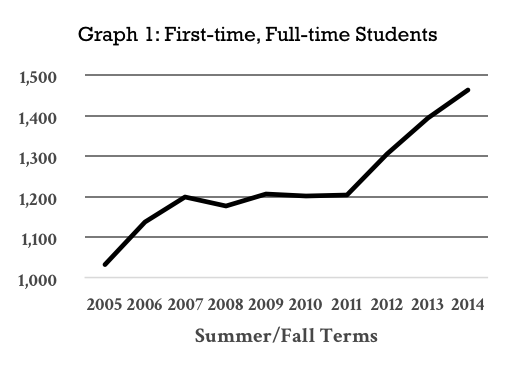
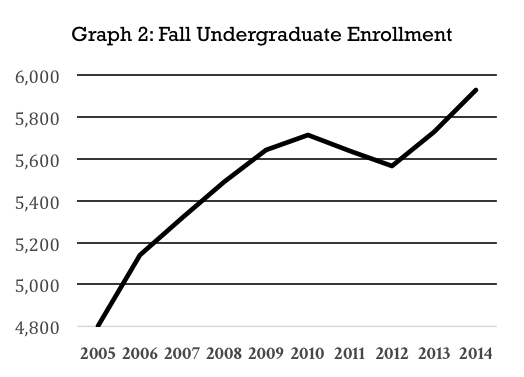

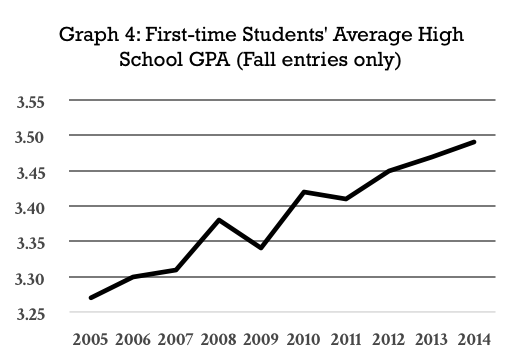
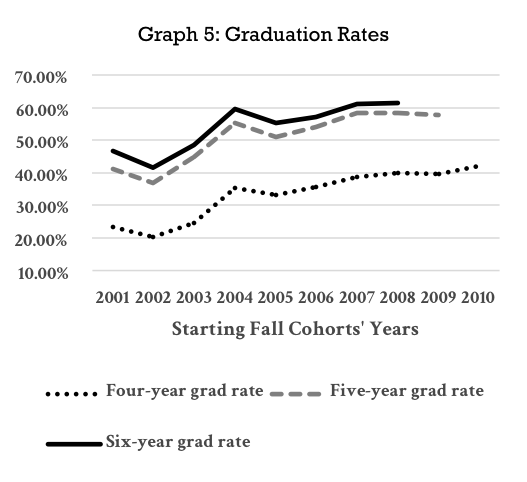
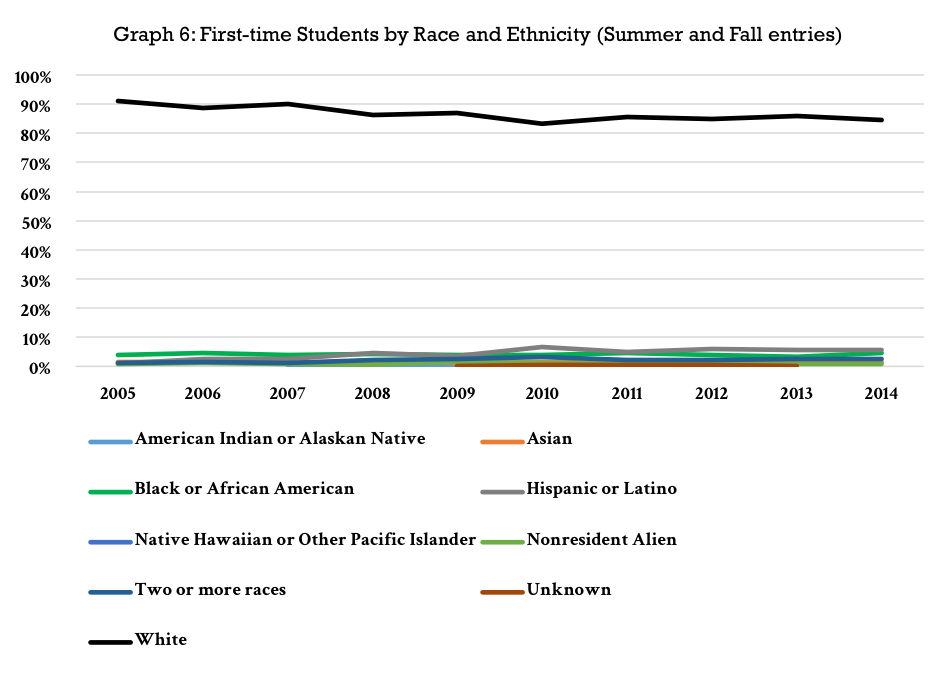
Institutional Completion Goals, High-Impact Strategies and Activities
|
Goal |
1. Increase the number of undergraduate degrees awarded by USG institutions. |
||||||||||||||||||||||||||||||
|
High-impact strategy |
Increase high school completion in GC’s Early College program by 5% annually and the earning of college credit by the time of high school graduation by 5% over the next two years. |
||||||||||||||||||||||||||||||
|
Summary of Activities |
Data presented below demonstrate a decline in students graduating from GCEC between 2014 and 2015 and, subsequently, the number of students opting to enroll at Georgia College. With respect to college credits earned, while there was a slight dip from 2012 to 2013, the number increased in 2014 with a range of 15-37 credits but then declined in 2015 to 9-32. Readers should also note that 2015 results were higher than in 2012 and 2013. Informally, GCEC administrators are cautiously optimistic that 2016 will see a return to the 2014 levels. Strategies that have helped achieve this objective have included:
|
||||||||||||||||||||||||||||||
|
Baseline Status |
The measures identified for this strategy remain appropriate and will continue to be applied for this item. Note: 2011-12 data provided in the table below served as the baseline measure for all subsequent GCEC activities. |
||||||||||||||||||||||||||||||
|
Interim Measure of Progress |
Data from the GCEC Class of 2014 were noticeably higher compared to other recorded years. While percentages are down from FY15 to FY14, the GCEC administration is still very proud of the Class of 2015’s achievements. The administration had predicted that only 5 students would complete the program, so these results were very encouraging. The administration is anticipating that 26 students will complete the program in 2016 with a college credit range of 9-42.
|
||||||||||||||||||||||||||||||
|
Measure of Success |
% students graduating from GCEC compared to original class enrollment Number of college credits awarded to GCEC graduates in each of the past three years |
||||||||||||||||||||||||||||||
|
Lessons Learned |
Attainment of this goal and strategy will result in greater access to Georgia College for a traditionally underserved group in the Middle Georgia area. Furthermore, because these students will enter GC with awarded college credit, there is a greater potential for these students to complete their degrees in four years. Challenges for Georgia College Early College (GCEC) students attaining the goal are identified below with activities to remedy the situation: 1. MENTORSHIPS: As previously stated in last year’s report, most GCEC students do not come from environments that support them in furthering their education. Their lack of knowledge and reluctance to ask for help causes a series of negative events to occur when they begin their college courses. GCEC offers college support classes and have teachers monitoring them, but that interaction depends upon teachers having a free period of time during the day to assist. Need: GCEC needs mentors, more college students intentionally interacting with our students. Activities:
2. COLLEGE RIGOR/CONTENT COLLABORATION: GCEC continues with two academic challenges: making sure its students master the state's common core standards and ensuring that students are ready for college content. Although our students master state standards, they are not always ready for the rigor of college courses. Need: GCEC needs more scheduled collaborations with college instructors to ensure its students are ready for college content. To date, GCEC has had successful collaborations with the theater, nursing, philosophy, political science, and science departments regarding specific activities but not centered on curriculum and instructional issues. Activity:
3. CHALLENGE: COMMUNICATION: There is a need for a greater sharing of student program information and progress between Academic Advising and the GCEC administration, including, but not limited to, sharing mid-term grades (with students’ permission) and collaborating on effective student success strategies. Activities:
Summary GCEC has no intention of increasing the number of students in the program. However, with improvements in retention due to the work described above, graduation rates are anticipated to increase. Furthermore, the GCEC administration is hopeful that 100% of its Class of 2016 will graduate on time; and 4-6 students have already targeted Georgia College as their university of choice. |
|
Goal |
4. Provide intrusive advising to keep students on track to graduate. |
|
High-impact strategy |
Restructuring the Academic Advising area for greater efficiency and effectiveness using data analytics to better predict student success. |
|
Summary of Activities |
FY’15 completed our first year utilizing “upper level” academic advisors. Eighteen (18) professional academic advisors now provide advising for all undergraduates. Academic departments encourage faculty members, now free from the administrative aspects of academic advising, to serve instead as academic mentors to students in their departmental major(s), to shepherd them through their upper-level courses, conduct undergraduate research with students, and help to develop the students’ plans for graduate school, professional school, or the career world. A new Associate Provost was hired in January 2015 to oversee an expanded Center for Student Success. This new sector in Academic Affairs houses the Academic Advising Center and other resources dedicated to student achievement – the Bridge Scholars Program, The Learning Center, The Testing Center, Leadership Programs, and the Honors and Scholars Program. The Academic Advising Center is currently working to implement a modified structure, utilizing “advising clusters” in order to cross-train academic advisors and better accommodate and manage advising caseloads. Presently, our advising clusters consist of:
Each cluster has a “Lead Advisor” (an Academic Advisor II) who supervises two or three Academic Advisor I positions. We have arranged our “clusters” so that each advisor will have an advising load of approximately 300 to 350 students. Lead Advisors typically have a slightly lower advising case load due to their supervisory responsibilities and their liaison efforts with their academic departments /colleges. In Fall 2015, professional advisors in the Academic Advising Center served 5,746 students. As the final seniors still with faculty advisors from the old advising arrangement graduate and move out of the pipeline, the Advising Center’s number of advisees will increase slightly as all undergraduates are eventually served in our department. FY’16 will now see a shift of our advisor-advisee assignments to a four-year model, so that our academic advisors will have the opportunity to truly get to know their students and have deeper working relationships with their advisees. A stronger working relationship between student and advisor is expected to positively impact retention. For example, our academic advisors place a special emphasis on monitoring advisees’ credit hour registration, to encourage students to target 30 earned credit hours a year. Now that the bulk of our centralized professional advising transition is complete and our model is set, GC will seek to capture baseline data on elements such as earned credit hour rates and retention by academic advisor and/or advising cluster. |
|
Baseline Status |
The measures identified for this strategy remain appropriate and will continue to be applied for this item. |
|
Interim Measure of Progress |
|
|
Measure of Success |
Retention rates for Y1:Y2 and Y2:Y3 annually for five years In 2012, the established baseline measure was “by FY15, Georgia College seeks to attain an 86% rate of retention of students from the first year into the second year, representing a 3-percentage point increase over current benchmark data.” This target has been achieved; and moving forward, Georgia College will increase Y1:Y2 retention by 1% in FY17. |
|
Lessons Learned |
The Student Success Collaborative (SSC) provides predictive information to academic advisors to identify students who, though in good academic standing, may be in danger of not graduating in their intended major. SSC performs these analytics by comparing students’ performance in key courses with those of students who have been successful in the same major. It also helps to identify majors that are strong matches in the event students are not performing adequately in their first choice. All academic advisors at Georgia College have now been using the SSC platform for one complete year. For declared and undeclared students alike, the system allows advisors to record meetings and other contacts, to keep track of meeting and contact notes, and to assign select students to a “watch list” for additional monitoring and follow-up. Most importantly, the SSC platform generates alerts to advisors of students who may be at risk for leaving the university – either by virtue of performance/grades or perhaps missed milestones – important courses that must be taken in sequence or by a chronological target date. Advisors are able to then follow-up with the at-risk students to help them correct their path and/or connect them with key resources to improve their academic performance. According to data from our SSC platform during the period of Fall 2014 to Spring 2015, 65% of the students who worked with their academic advisor realized decreases in retention risk (N=2,699 students). In addition, for the same time period, 65.3% of students who worked with our professional advisors to switch majors, according to our SSC data (N=2,699 students), did so. While our professional academic advisors have incorporated basic use of the SSC platform into their daily work with students, the Academic Advising Center is now working with its staff to move toward more advanced use of the platform, such as using it for targeted campaigns to specific groups of students. We have realized there is a close link between Academic Advising and the Career Center. To that end in July 2015, the Academic Advising Center assigned one advisor to serve as the Advising Center’s Liaison to the Career Center. The responsibility of this position will be to meet regularly with the administration of the Career Center to learn about the Career Center’s advising goals and practices and to determine ways that the Advising Center staff can begin to mirror and support the advising strategies of career counselors in academic advising sessions. With a responsibility now for four-year advising, advisors will provide career advising and track and encourage career-building opportunities among their students. “Advising clusters” are effective organizational models for increasing the efficiency and organizational engagement of each advisor. Advising clusters also complement the focus at Georgia College on students choosing their majors early in their academic career. By being in a cluster, which focuses on advising similar majors, advisors are able to, cross-train and better accommodate and manage advising caseloads. Working in similar areas, advisors also become well aware of requirements for similar majors and can advise students more appropriately when students make major changes in the same area cluster. The “ advising cluster” model combined with the new four-year advising model will allow academic advisors to intervene early, track their students more effectively, and develop more meaningful relationships with their advisees overall. We believe the benefits of “Advising Clusters” will increase student satisfaction and positively impact student retention and graduation. Moving forward, because Georgia College is still in the beginning stages of utilizing Education Advisory Board: SSC, we have asked the collaborative to assist us in completing a longitudinal internal tracking process to determine how our advising efforts are impacting retention and graduation. So while we do not have the longitudinal data to report this year, we will begin the collection of these data and will be able to provide results in future reports. |
|
Goal |
6. Shorten time to degree completion through programs that allow students to earn college credit while still in high school and by awarding credit for prior learning that is verified by appropriate assessment. |
|
High-impact strategy |
Increase the number of Dual Enrolled students taking GC classes and earning college credit prior to high school graduation |
|
Summary of Activities |
Georgia College Office of Admissions has reached out to local schools to offer assistance for students enrolling dually in high school and college. Admission counselors also work with high school counselors to encourage students all over Georgia to take advantage of dual enrollment opportunities in their local communities to gain advance credit and also improve their admission portfolio when considering application to Georgia College. The change in the funding model for dual enrollment from the Accel Program to Move On When Ready will make taking college courses in high school possible as some families were not able to afford this in the past. Under Move On When Ready funding, families will receive funding for all tuition, mandatory fees, and the use of required textbooks. The Office of Admissions will work closely with local schools to explain the benefits of this program. |
|
Baseline Status |
The measures identified for this strategy remain appropriate and will continue to be applied for this item. Baseline measures used to determine success were from 2011 (see below): Fall 44 and Spring 57. |
|
Interim Measure of Progress |
|
|
Measure of Success |
Number of students in the dual enrollment program. |
|
Lessons Learned |
Any college credit that students can earn while still enrolled in high school not only shortens time to degree but also serves as preparation for postsecondary education after high school. Georgia’s Accel Program has provided funding to assist with the cost of tuition, but some families struggle with the cost of mandatory fees. Georgia College has waived the mandatory fees for first generation dual enrollment students who are part of our Early College Program. This has allowed these students to take college courses with no out-of-pocket cost with the exception of textbooks. The additional fees have proven problematic for some families resulting in the Fall 2014 decrease in enrolled students. However, beginning Fall 2015, funding for these students will be available through Move On When Ready, which will cover the cost of mandatory fees and textbooks. In addition to offering dual enrollment, Georgia College encourages entering students to enroll in Advanced Placement (AP) courses in high school with the intent to exempt college courses by AP exam score. At the time this report was being prepared, our first two batches of AP score results arrived at GC. While we will receive other score reports throughout the remainder of summer, the initial shipments received in early July are always the largest. From this first group of score reports, 566 incoming first-year students (39% of our freshman class) have received some form of academic credit that is applicable toward their degree. The total amount of academic credit awarded from this first round of evaluations equals 4,406 credit hours. |
|
Goal |
8. Restructure instructional delivery to support educational excellence and student success. |
||||||||||||||||||||||||||||||||
|
High-impact strategy |
Increase course completion rate by 5% in core mathematics courses using the Math Emporium redesign process. |
||||||||||||||||||||||||||||||||
|
Summary of Activities |
The College Algebra Emporium was piloted in Fall 2011. Since then, the program has been assessed on an annual basis with modifications made where appropriate to improve its effectiveness. Evidence of the program’s success is provided in the chart below (MATH 1111 College Algebra), which shows increases in ABs and declines in DFWs and Ws across the four years. Modifications made since 2012 continue to have a positive effect on student success, and no additional changes were made in AY 14-15. The Department of Mathematics continues to monitor all aspects of the Emporium Model’s delivery. |
||||||||||||||||||||||||||||||||
|
Baseline Status |
The measures identified for this strategy remain appropriate and will continue to be applied for this item. AY 11-12 (see below) served as baseline measures to determine success of future activities. |
||||||||||||||||||||||||||||||||
|
Interim Measure of Progress |
MATH 1111 College Algebra
The results for 2012-2013, 2013-2014, and 2014-2015 suggest that the College Algebra Emporium is having a very positive effect on student success in freshman-level math. These results are extremely encouraging as measured by the DFW-rate and the AB-rate. During these three years, the average DFW-rate in College Algebra was 18%. This is a decrease from the 24% DFW-rate which was typical in MATH 1101 Math Modeling. During these three years, the AB-rate in College Algebra has averaged 68% as compared to the 57% AB-rate which was typical in Math Modeling. The withdrawal rate in College Algebra has averaged 8%, a decrease from the withdrawal rate of 12%, which was typical in Math Modeling. This lower withdrawal rate is very encouraging, all the more so because those students who do persist in the course tend to do very well. The improvements in the AB, DFW, and W-rates in College Algebra subsequent to Year 1 also suggest that the changes, which were implemented in the Emporium in Years 2 and 3, had a positive effect on student success. One of the goals of the College Algebra Emporium is to enhance the algebraic skills of our students so as to better prepare them for any subsequent mathematics courses they may take, particularly MATH 1113 Precalculus and MATH 2600 Probability and Statistics, both of which are Area D core courses. We have done some preliminary tracking of those students who took College Algebra in Year 1 and who then went on to take either MATH 1113 or MATH 2600. The results we found are positive and very encouraging. Of the students who received ABC in College Algebra in Year 1 and who went on to take either MATH 1113 or MATH 2600 as their subsequent math course, 63% received ABC in the subsequent course. When we look at the analogous data for students who took MATH 1101 instead of MATH 1111, we find that of the students who received ABC in MATH 1101 and who went on to take either MATH 1113 or MATH 2600 as their subsequent math course, 54% received ABC in the subsequent course. These data suggest that the College Algebra Emporium provides better preparation for MATH 1113 and MATH 2600 than does MATH 1101. We followed up this preliminary tracking by looking at the students who took MATH 1111 College Algebra during the period Fall 2011 – Spring 2014 and at their performance in their subsequent courses, specifically MATH 1113 Precalculus and MATH 2600 Probability and Statistics. We did the same thing for students who took MATH 1101 Math Modeling or MATH 1001 Quantitative Skills & Reasoning during the same time period. The results of this study continue to indicate the better preparation provided by the College Algebra Emporium. To date, the only course offered in the Emporium has been MATH 1111 College Algebra. This course is one of the options to satisfy Area A of a student’s core curriculum requirements. Another such course is MATH 1101 Math Modeling. We would like to enlarge the scope of our course redesign initiative so as to offer Math Modeling as well as College Algebra via the Emporium. If done properly, the Emporium can then accommodate students from both courses simultaneously. Thus, the College Algebra Emporium would become a true Math Emporium. Preliminary planning is already under way for this, and the hope is to implement this initiative in Fall 2015. |
||||||||||||||||||||||||||||||||
|
Measure of Success |
AB, DFW, and W-rates for the College Algebra Emporium across three years. |
||||||||||||||||||||||||||||||||
|
Lessons Learned |
College Algebra Emporium, MATH 1111 was designed to improve success and completion rates of non-STEM students taking their Area A Math course. Prior to the introduction of the College Algebra Emporium, students took MATH 1101 Math Modeling. MATH 1101 Math Modeling
The corresponding rates for the first four years of the Emporium: MATH 1111 College Algebra
The results for 2012-13, 2013-14, and 2014-15 suggest that the College Algebra Emporium is having a positive effect on student success in freshman-level math particularly DFW rates compared to MATH 1101 Math Modeling. The charts above provide evidence that the changes implemented in 2014 (Georgia College’s August 1, 2104, CCG report) continue to have a positive effect on student success. Given the success of the Math Emporium model over the past four years, the Department of Mathematics would like to enlarge the scope of the course design sequence and offer Math Modeling as well as College Algebra via the Emporium. |
Observations
What strategies and activities have been most successful?
Math Emporium
As evidenced by data provided in this report, the Math Emporium model appears to have stabilized and continues to be one of Georgia College’s greatest instructional delivery successes. The Mathematics Department has worked diligently to develop a model that has led to increases in students’ performance. Given the success, the department would like to enlarge the scope of the course design sequence and offer Math Modeling as well as College Algebra via the Emporium.
Student Success Collaborative (SSC)
The use of SSC as a predictive tool in identifying students at academic risk allowed for advisor intervention resulting in a 65% decrease in the number of at-risk students. In addition, for the same period, 65.3% of students who worked with new professional advisors to switch majors did so according to SSC data (N=2,699 students).
What have been least effective?
GCEC
Data presented on page six identified a decline in students graduating from GCEC between 2014 and 2015 and, subsequently, the number of students choosing to enroll at Georgia College. While there was a slight dip in college credits earned from 2012 to 2013, the number increased in 2014 with a range of 15-37 credits but then declined in 2015 to 9-32. However, the 2015 results were higher than in 2012 and 2013. GCEC administrators are cautiously optimistic that 2016 will see a return to the 2014 levels.
Dual Enrollment
The number of students participating in dual enrollment showed a decrease in Fall 2014. Results of surveys indicate the primary barrier is one of financial resources. However, the restructuring of the dual enrollment program into Move On When Ready (MOWR) provides funding for essentially all costs for families, therefore, removing this barrier. This change is effective Fall 2015.
Has your institution made adjustments to completion activities over the past three years?
If so please explain why.
Center for Student Success
Since the arrival of the new Associate Provost and Director of Student Success in January 2015, there has been a renewed focus in terms of reviewing measures in place since the advent of CCG and identifying areas in need of a enhancement to improve retention and graduation rates of Georgia College students. As a result of these discussions, the following four areas have been targeted for implementation:
- Area Cluster Advising: Beginning Fall Semester 2015, the Academic Advising Center will implement a new organizational structure that “clusters” advisors together into five major academic areas: humanities and education, social sciences, physical and life sciences, business, and health sciences. Each advising cluster will be assigned a “lead advisor.” This model will allow advisors in similar academic areas to improve the depth of their understanding of requirements for the major in each area, improve their relationships with area faculty, and thus provide more informed and strategic advice to students in the cluster majors regarding how to progress effectively to graduation. The area cluster model will also allow cross–training for advisors in the similar academic areas, better facilitation of changes in the major, and, with closer supervision, greater opportunity to identify and quickly solve any problems with advising knowledge and delivery.
- Four-Year Advising: Beginning Fall Semester 2015, academic advisors will begin four-year advising. Advising students all four years, instead of changing advisors after two years, will allow advisors to develop quality relationships with their students, intervene effectively when students have difficulties, and track the progression and retention of their advisees over four years. To support the four-year advising model, the Student Success Collaborative will provide retention reports tied to specific advisors. These reports, with real-time data for each advisee, will provide greater opportunity for early intervention by the advisors, help develop analytical models for advising best practices, and provide an outcome-incentive to advisors to make sure that their advisees are progressing successfully.
- Increased Emphasis on the Value of a Liberal Arts Education: In keeping with the renewed emphasis on Georgia College’s mission as a public liberal arts university, academic advisors will begin to participate in discussion groups to develop a consistent message about the value of the liberal arts and a more intentional strategy for articulating this value to their advisees. We believe that when students have a greater understanding of the value of a liberal arts education for both self-development and career advancement, they will be more likely to have a satisfying educational experience at Georgia College that will yield greater retention and progression to graduation.
Math Emporium Model
Modifications made since 2012 continue to have a positive effect on student success, and no additional changes were made in AY 14-15. The Department of Mathematics continues to monitor all aspects of the Emporium Model’s delivery.

